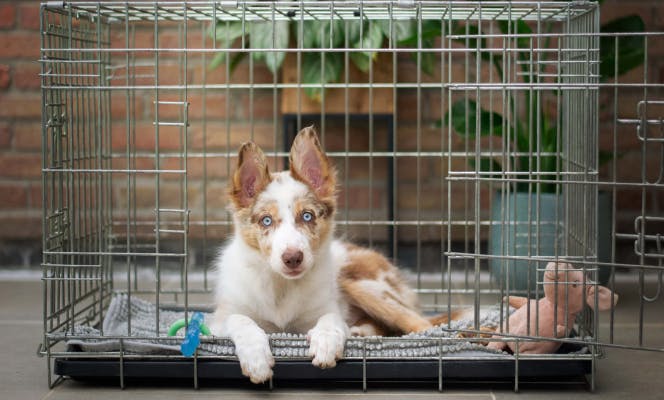9 Tips for Your Puppy's First Week
By Mawoo Pets · 11 min read
Last updated: January 27th, 2024

What could be more exciting than bringing home a playful, loving puppy? The first few days with your new puppy will be filled with excitement and fun, but there are bound to be a few surprises along the way–for you and for your pet.
The first week with a puppy is the most worrying. Focus on getting through your first seven days together and by the end of it both of you will be relaxed enough to really start bonding and enjoying each other’s company. We have 9 great tips for making those first seven days truly unforgettable–and as stress-free as possible!
For your pet, there’s a whole new world to explore in your house, yard and neighbourhood. Every single thing is brand new. All he or she has he’s ever known is their doggy family and the breeder’s home.
Going into a new environment is bound to be scary! Not only will your puppy be nervous, but you are likely to be a bit nervous, too. A little advanced preparation goes a long way…and it will set you both up for success in the coming weeks.
If you’ve decided you’re ready to get a puppy, we have 9 great tips for making those first seven days truly unforgettable–and as stress-free as possible! First, check out this brief guide to getting your home ready for your little newcomer.
Preparing for Puppy’s First Week in a New Home
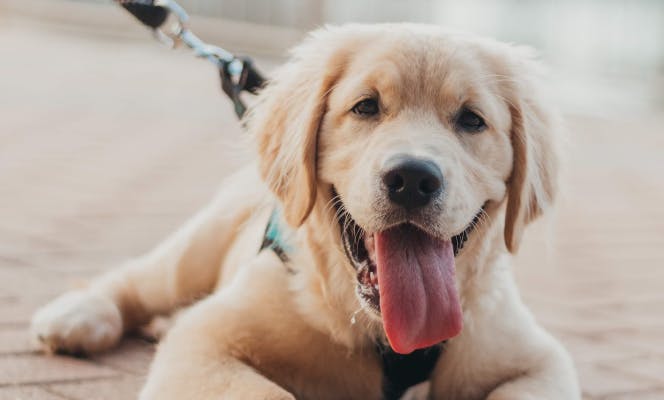
If possible, visit your puppy a few times before bringing him or her home. That way, your scent, voice and presence will be familiar when it’s time to move in together. Be sure to ask the breeder lots of questions about the puppy’s routine, including details about mealtime and any potential health issues.
If you can work it out, plan to pick up your puppy right before a long weekend or holiday so the two of you can spend as much time together as possible during your crucial first days as roommates. Puppy will need a crate for the car ride home, so it’s easy for you to keep her safe and in one place.
Take a walk before the ride to try to prevent accidents in the car–but don’t be too surprised if you have to deal with a potty accident or tummy troubles along the way. Keep paper towels, wet wipes, water and a garbage bag on hand just in case.
Puppy Proof Your Home
Puppy proofing is essential! If your belongings aren’t packed up safely, they’re fair game for a curious and energetic puppy. It helps to get down on your puppy’s level and go from room to room looking for anything that’s easy to chew on.
Things like electrical cords, remote controls, cleaning supplies, medications/supplements, and houseplants can all be dangerous for your puppy. They should be kept out of your puppy’s reach in a locked cabinet or in a room he won’t have access to.
Things like shoes and kids’ toys won’t necessarily harm your puppy, but you don’t want him to chew on them, either. The same goes for other pets who won’t appreciate being chewed on or played with. If you have a kitty, make sure the puppy can’t access her litter box…kitty box adventures are a habit you really want to avoid. Baby gates can be used to keep your puppy out of restricted areas.
Buy Basic Supplies
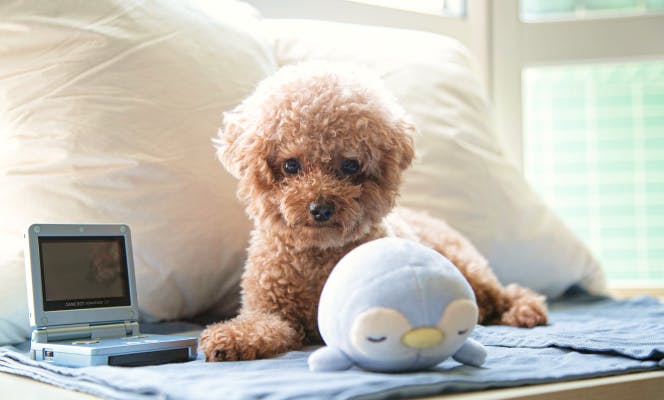
Buying your basic supplies in advance is key for a successful first week with a puppy. Here’s a list of what you’ll need on hand:
Leash and collar with ID tag
Food and water bowls
Puppy food and treats (Check with your puppy’s breeder to see what he’s currently eating. You don’t make any changes right away.)
A crate and comfy bed
Puppy-safe toys
Poop bags
Don’t forget an enzyme cleaner and paper towels! Accidents are inevitable until your new puppy has potty training figured out.
Set Up a Puppy Safe Zone
Setting up a puppy safe zone is key for successful potty training and for keeping your puppy safe when you’re not available to supervise. A crate with a cozy bed is a good option for times when you’re only going to be away for an hour or two.
A crate placed inside a puppy playpen works perfectly when you have to be away from home for several hours. The crate can be set up as a cozy sleeping space with food, water, toys and puppy pads for potty time.
Once your home is puppy-safe, you’re ready for that first week together!
9 Tips for the First Week with a New Puppy
1. Begin Potty Training
Routines are essential when house training a puppy. Potty training should begin the first day you bring your new puppy home. It’s much harder to retrain bad behaviors than it is to establish good ones, so don’t be tempted to wait until your puppy is settled in before taking this important step.
Be sure to feed your puppy according to the same schedule every day so he knows when to expect meals. This will keep him from getting anxious. Also, as soon as a meal or snack is finished, take him out to go potty. The same should be done when the puppy wakes up, and every two hours throughout the day. If you see him sniffing around, that’s your cue to know he is probably looking for a place to potty.
2. Introduce Your Pup to His Crate
Crate training is an essential part of raising a well-adjusted puppy, as it teaches your new pup that it’s okay to be alone sometimes. It also gives him a space of his own where he can go when he’s feeling overwhelmed or just wants to take a nap.
The crate is also something you can use to give your puppy a safe place while you are out of the house temporarily. Make it nice and cozy inside. Toss in a few treats and leave the door open for your puppy to investigate any time. You want him to associate the crate with good things! This is very important during potty training, since puppies usually understand not to potty in their safe space and bedding.
Once your puppy gets comfortable going in and out of the crate, close the door for a few minutes and walk away. Be sure to open the door before he gets anxious, and eventually you can leave him in for longer periods. He should be able to stay in his crate for an hour or two while you run an errand.
Keep in mind that young puppies need to go out every two hours, even when you’re not home. If you can’t arrange for a family member, friend or dog walker to take him out while you’re at work, doggie daycare may be a good option. As a last resort, you can put puppy pads down in his exercise pen for him to use when you’re not home.
3. Socialize Your Puppy

Socialization is an essential part of raising a well-adjusted puppy that gets along well with people and other animals. During the first week with your puppy, your focus should be on helping him bond with all the members of the household. It’s not a good idea to invite friends over to the house during this time, or it could be overwhelming for the new family member.
Part of the socialization process includes handling your puppy regularly. Make sure he gets used to being petted, touched and picked up multiple times throughout the day. Have fun cuddling him! Hold him in your lap, pick him up and hold his paws gently. Reward positive reactions with lots of praise, attention and treats. If he nips, say “no” sharply to communicate that aggressive behavior is not okay and then redirect his attention to a toy to chew on instead.
It’s also a good idea to slowly introduce your new puppy to other pets in the home. All interactions should be supervised and kept short during the first week. If there’s any sign of tension, give everyone a time out in their own space until things cool down.
During the first week with your new pup, go about your normal routine of vacuuming the floors, doing the laundry, mowing the lawn etc. As your new pet, your puppy needs to get used to the typical sounds he’ll hear from day to day. If he seems stressed by the noise, keep the sessions short until he gets used to it, but don’t stop them completely.
After the first week, it’s okay to have small groups of family and friends come by to meet the new puppy. Over time, try to expose him to things like rides in the car, passing bikes, children and traffic noise. A puppy manners class is a great place to introduce him to other puppies, once he gets the all-clear from your veterinarian to be around other dogs.
4. Set Some Ground Rules
Ground rules aren’t just for your puppy. They’re for your family, too. Will the puppy be allowed on the couch and bed? What areas of the house are off-limits? Who is responsible for feeding the puppy? What about those midnight potty breaks?
Getting all family members on the same page is key because puppies thrive on routines and consistency. Setting the house rules and sticking to them will help to ensure that everything will go smoothly, not just during the first week, but also throughout puppyhood and adulthood.
5. Begin Training Through Play
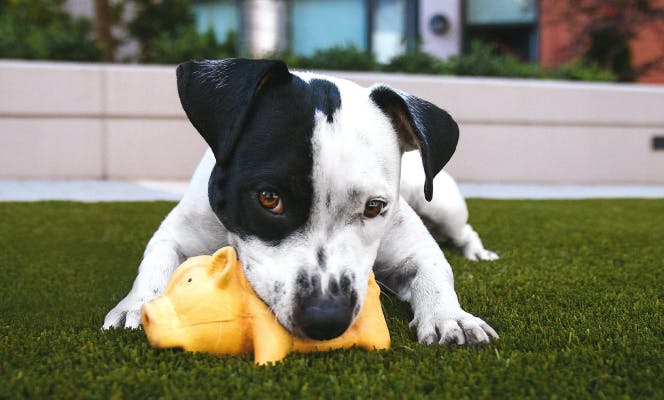
During the first week, you can begin training your puppy in some very basic commands through play. Keep sessions short and make them fun, with lots of praise and treats for rewards. As a starting point, begin by calling his name and offering a reward when he responds.
Once he learns his name, work on teaching him to come when called. Call his name and say “come” in a happy, encouraging tone. Backing away quickly for a few steps as you call will encourage him to follow. Make a big fuss with treats and praise when he comes to you.
6. Schedule Puppy’s First Vet Visit
A visit to your veterinarian should take place within the first week of having a puppy. He’ll need to have his first shots and a check-up to ensure that there aren’t any health concerns that need to be addressed. This first visit is also essential for introducing your puppy to your vet, which will help to make future visits less stressful. While you’re there, plan on having him microchipped, too!
7. Introduce the Leash and Collar
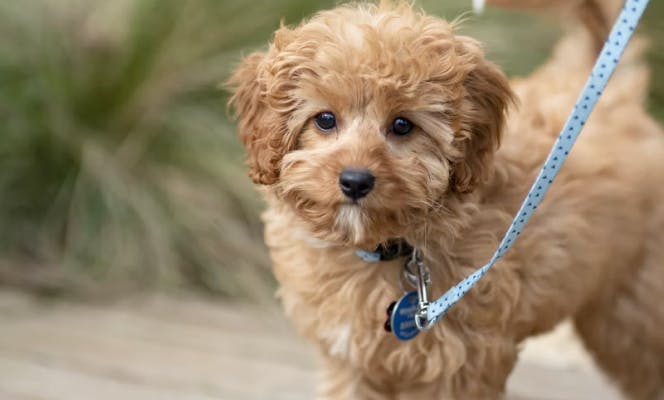
Leash training is one of the first lessons every dog should learn. The first time you put it on, he will probably find it restrictive and confusing, and pull in the opposite direction. To counteract this, use the positive reinforcement approach and reward him when he stands with the leash quietly.
After the first time, be sure to put his leash and collar on every time you go outside.
8. Getting Through the First Night
The first night with your new puppy can be tough for both him and you. He’s used to having his mom and littermates around for company and comfort, and will be lonely and confused without them. Facing unfamiliar surroundings is scary on your own, especially at night. The best way to get through the first few nights is to let your puppy sleep in your bedroom (but not in your bed!)
Put his crate near the head of your bed and let him sleep there for at least the first few nights. This will help your pup feel safe and secure, knowing you’re close by. It will also establish his crate as his safe place. Over time, you can move the crate to a different part of the house if you prefer.
Although some breeds are couch potatoes by nature, a good play session or walk to tire your pup out before bedtime is still a great idea. A tired puppy is much more likely to sleep during his first nights in a new home. Be sure to take him out to go potty right before bed, and a few times during the night as well.
9. Focus on Positive Reinforcement and Redirection, Not Punishment
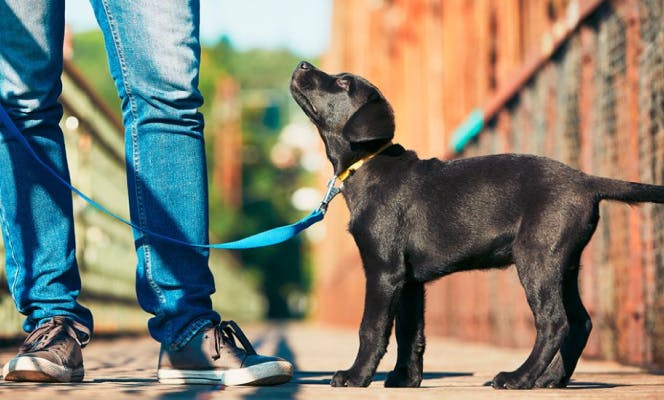
Positive reinforcement and redirection go a lot further than punishment when it comes to puppy training. Give your puppy extra attention when he’s calm, to reinforce that part of his personality. Offer him praise when he goes to the bathroom outside and responds to your commands. Giving your puppy attention will reinforce this good behavior.
If there is no good behaviour to praise, try not to punish the bad. Instead of shouting or crating your puppy for unwanted barking and whining, try ignoring it (unless he needs to go out). Instead of punishment for him for chewing on something he shouldn’t, redirect his attention to one of his toys.
Wrapping Up: Beyond the First Week
Once your pup has had a chance to settle in, you can begin to teach him more advanced commands like sit, stay and lie down. Introduce your puppy to as many new people and environments as possible. The more positive encounters he has now, the more well-behaved and better adjusted he’ll be as an adult. Enjoy your new puppy!
Related articles
Related puppies for sale
Any questions? Get in touch!
We are here to support you every step of the way. Our concierge service is here daily to answer your questions!
Chat or speak with our team Mon-Sat 9a-9p ET.
